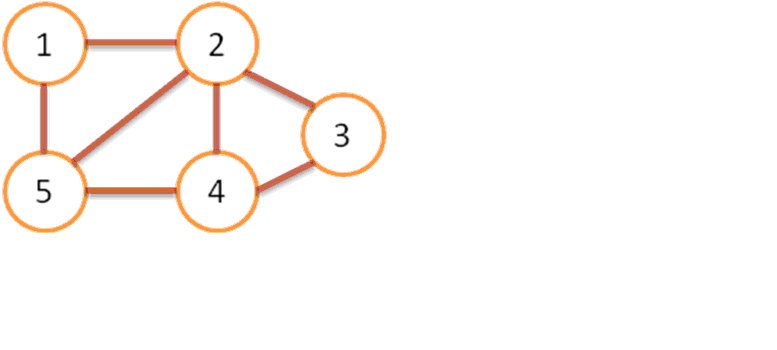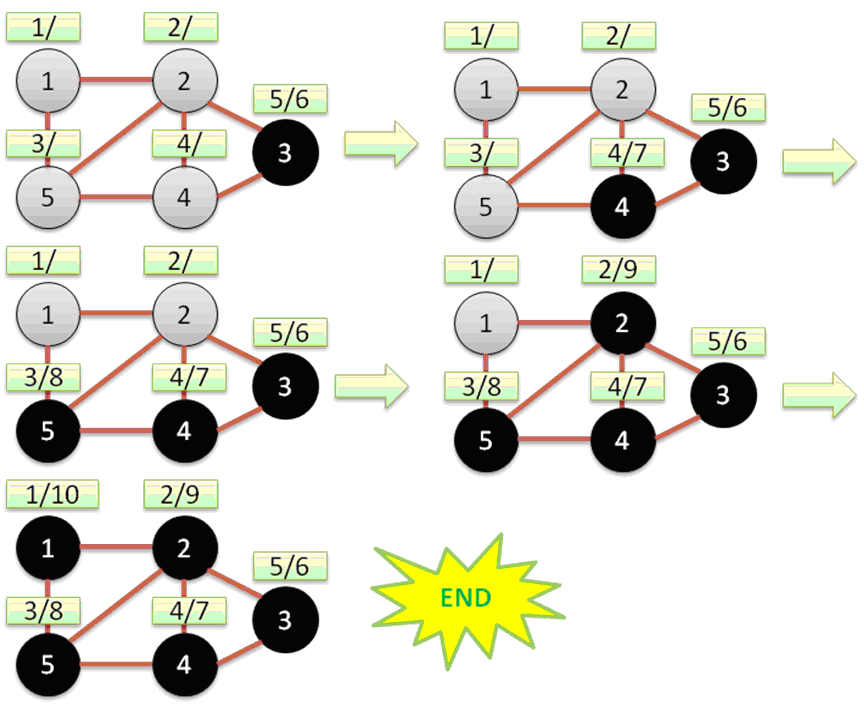深度优先(DFS)
来源:互联网 发布:淘宝大件退货 编辑:程序博客网 时间:2024/04/29 21:33
算法的伪代码描述为:
DFS(G)
1 for each vertex u ∈ V [G]
2 do color[u] ← WHITE
3 π[u] ← NIL
4 time ← 0
5 for each vertex u ∈ V [G]
6 do if color[u] = WHITE
7 then DFS-VISIT(u)
DFS-VISIT(u)
1 color[u] ← GRAY ▹White vertex u has just been discovered.
2 time ← time +1
3 d[u] time
4 for each v ∈ Adj[u] ▹Explore edge(u,v).
5 do if color[v] = WHITE
6 then π[v] ← u
7 DFS-VISIT(v)
8 color[u] ←BLACK ▹ Blacken u; it is finished.
9 f [u] ←time ← time +1
在程序中,d[u]表示为first[u],f[u]表示为last[u]
下面代码中使用邻接表(adjacency list)来表示,结构如下图所示:

根据上述算法描述深度优先的过程图示如下:
其中顶点上面的标志为 first(v)/last(v)即第一次访问该结点的时间和最后一次访问该结点的时间


算法实现代码如下:
package _20120204;import java.util.ArrayList;public class DFS {public String[] color;public int[] parent;public int[] first;public int[] last;public int time = 0;public ArrayList<ArrayList<Integer>> graph = new ArrayList<ArrayList<Integer>>();public ArrayList<ArrayList<Integer>> graph(){int[] sub1 = {1,2,5};int[] sub2 = {2,1,5,3,4};int[] sub3 = {3,2,4};int[] sub4 = {4,2,5,3};int[] sub5 = {5,4,1,2};graph.add(creatList(sub1));graph.add(creatList(sub2));graph.add(creatList(sub3));graph.add(creatList(sub4));graph.add(creatList(sub5));return graph;}/** * make an array to a list... * @param source * @return */public ArrayList<Integer> creatList(int[] source){ArrayList<Integer> subList = new ArrayList<Integer>();for(int i = 0;i < source.length;i++){subList.add(source[i]);}return subList;}public DFS(){this.graph();color = new String[graph.size()];first = new int[graph.size()];last = new int[graph.size()];parent = new int[graph.size()];for(int i = 0;i < graph.size();i++){color[i] = "white";parent[i] = -1;}for(int i = 0;i < graph.size();i++){if(color[i].equals("white")){DFS_VISIT(i);}}for(int i = 0;i < graph.size();i++){System.out.println("节点 "+(i+1)+" 的父节点为 "+this.parent[i]);}}public void DFS_VISIT(int node){ System.out.println("当前访问的节点是: "+(node+1));color[node] = "gray";this.time = this.time+1;first[node] = this.time; System.out.println("第一次访问节点 "+(node+1)+" 的顺序为: "+first[node]);for(int i = 1;i < graph.get(node).size();i++){if(color[graph.get(node).get(i)-1].equals("white")){parent[graph.get(node).get(i)-1] = node+1;DFS_VISIT(graph.get(node).get(i)-1);}}color[node] = "black";this.time = this.time+1;last[node] = this.time; System.out.println("最后一次访问节点 "+(node+1)+" 的顺序为: "+last[node]);}public static void main(String[] args){DFS dfs = new DFS();}}程序运行结果如下:
当前访问的节点是: 1
第一次访问节点 1 的顺序为: 1
当前访问的节点是: 2
第一次访问节点 2 的顺序为: 2
当前访问的节点是: 5
第一次访问节点 5 的顺序为: 3
当前访问的节点是: 4
第一次访问节点 4 的顺序为: 4
当前访问的节点是: 3
第一次访问节点 3 的顺序为: 5
最后一次访问节点 3 的顺序为: 6
最后一次访问节点 4 的顺序为: 7
最后一次访问节点 5 的顺序为: 8
最后一次访问节点 2 的顺序为: 9
最后一次访问节点 1 的顺序为: 10
节点 1 的父节点为 -1
节点 2 的父节点为 1
节点 3 的父节点为 4
节点 4 的父节点为 5
节点 5 的父节点为 2
根据结果得到顶点的访问次序如下图所示:

- 深度优先搜索 DFS
- 深度优先搜索 DFS
- 深度优先遍历DFS
- DFS 深度优先搜索
- 深度优先(DFS)
- dfs深度优先算法
- DFS 深度优先搜索
- 深度优先搜索(DFS)
- DFS-深度优先遍历
- 深度优先搜索(DFS)
- DFS深度优先遍历
- 深度优先搜索DFS
- DFS深度优先搜索
- 深度优先遍历(DFS)
- 深度优先搜索(DFS)
- dfs深度优先搜索
- dfs 深度优先搜索
- 深度优先搜索(DFS)
- Cortex-M3的PendSV中断以及uCOS系统一点思考
- Windows XP下CentOs 5.4的硬盘安装
- oralce海量测试数据的生成方案
- Python sort sorted函数详解
- Windows 7下CentOs 6的硬盘安装
- 深度优先(DFS)
- 函数WaitForMultipleObjects整理
- android程序退出当前activity的方法
- JAVA 的程序流
- 30days 改变自己~
- 工作后能捡起英语的三个网站
- Windows程序设计实现hello world
- 01背包——HDOJ 1864
- 注册OCX控件


